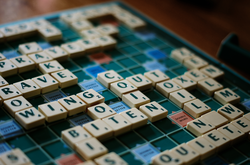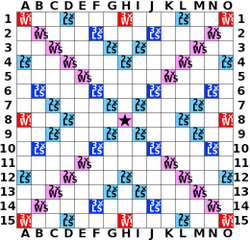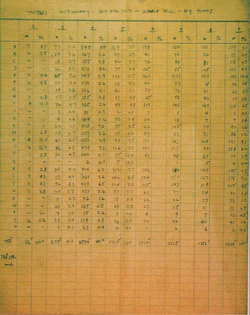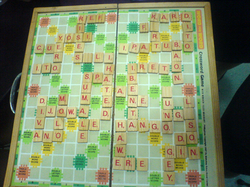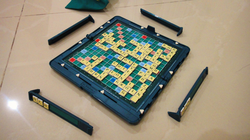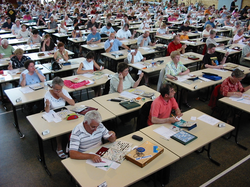Scrabble
Scrabble
| Manufacturer(s) | Mattel(outside U.S. and Canada)Hasbro(within U.S. and Canada) |
|---|---|
| Designer(s) | Alfred Mosher Butts |
| Publisher(s) | James Brunot |
| Publication date | 1938 |
| Genre(s) | Word gameBoard game |
| Players | 2–4 |
| Setup time | 2–6 minutes |
| Playing time | NASPAtournament game: ~50 minutes |
| Random chance | Medium (letters drawn) |
| Skill(s) required | Vocabulary,spelling,Anagramming,strategy,counting,bluffing,probability |
Scrabble is a word game in which two to four players score points by placing tiles bearing a single letter onto a board divided into a 15×15 grid of squares. The tiles must form words which, in crossword fashion, read left to right in rows or downwards in columns, and be defined in a standard dictionary or lexicon.
The name is a trademark of Hasbro, Inc. in the United States and Canada; outside the United States and Canada, it is a trademark of Mattel. The game is sold in 121 countries and is available in 29 languages; approximately 150 million sets have been sold worldwide and roughly one-third of American and half of British homes have a Scrabble set. There are around 4,000 Scrabble clubs around the world.
| Manufacturer(s) | Mattel(outside U.S. and Canada)Hasbro(within U.S. and Canada) |
|---|---|
| Designer(s) | Alfred Mosher Butts |
| Publisher(s) | James Brunot |
| Publication date | 1938 |
| Genre(s) | Word gameBoard game |
| Players | 2–4 |
| Setup time | 2–6 minutes |
| Playing time | NASPAtournament game: ~50 minutes |
| Random chance | Medium (letters drawn) |
| Skill(s) required | Vocabulary,spelling,Anagramming,strategy,counting,bluffing,probability |
Game details
The game is played by two to four players on a square board with a 15×15 grid of cells (individually known as "squares"), each of which accommodates a single letter tile.
In official club and tournament games, play is between two players or, occasionally, between two teams each of which collaborates on a single rack.
The board is marked with "premium" squares, which multiply the number of points awarded: eight dark red "triple-word" squares, 17 pale red "double-word" squares, of which one, the center square (H8), is marked with a star or other symbol; 12 dark blue "triple-letter" squares, and 24 pale blue "double-letter" squares.
In 2008, Hasbro changed the colors of the premium squares to orange for TW, red for DW, blue for DL, and green for TL.
Despite this, the original premium square color scheme is still the preferred scheme for Scrabble boards used in tournaments.
In an English-language set, the game contains 100 tiles, 98 of which are marked with a letter and a point value ranging from 1 to 10.
The number of points of each lettered tile is based on the letter's frequency in standard English writing; commonly used letters such as vowels are worth one point, while less common letters score higher, with Q and Z each worth 10 points.
The game also has two blank tiles that are unmarked and carry no point value.
The blank tiles can be used as substitutes for any letter; once laid on the board, however, the choice is fixed.
Other language sets use different letter set distributions with different point values.
Tiles are usually made of wood or plastic and are 19 by 19 millimetres (0.75 in × 0.75 in) square and 4 mm (0.16 in) thick, making them slightly smaller than the squares on the board.
Only the rosewood tiles of the deluxe edition varies the width up to 2 mm (0.08 in) for different letters.
Travelling versions of the game often have smaller tiles (e.g. 13 mm × 13 mm (0.51 in × 0.51 in)); sometimes they are magnetic to keep them in place.
The capital letter is printed in black at the centre of the tile face and the letter's point value printed in a smaller font at the bottom right corner.
S is one of the most valuable tiles in English-language Scrabble because it can be appended to many words to pluralize them (or in the case of most verbs, convert them to the third person singular present tense, such as the word LAUGHS); Alfred Butts included only four instances to avoid a game that was "too easy". Q is considered the most problematic letter, as most words with it also contain U; a similar problem occurs in other languages like French, Dutch, Italian and German. J is also difficult to play due to its low frequency and a scarcity of words having it at the end. C and V may be troublesome in the endgame, since no two-letter words with them exist, save for CH in SOWPODS.
History

The official Scrabble board design. Key: 2×LS – Double letter score 3×LS – Triple letter score 2×WS / ★ – Double word score 3×WS – Triple word score
In 1938, American architect Alfred Mosher Butts created the game as a variation on an earlier word game he invented called Lexiko . The two games had the same set of letter tiles, whose distributions and point values Butts worked out by performing a frequency analysis of letters from various sources, including The New York Times
In 1948, James Brunot, a resident of Newtown, Connecticut – and one of the few owners of the original Criss-Crosswords game – bought the rights to manufacture the game in exchange for granting Butts a royalty on every unit sold. Though he left most of the game (including the distribution of letters) unchanged, Brunot slightly rearranged the "premium" squares of the board and simplified the rules; he also changed the name of the game to "Scrabble", a real word which means "to scratch frantically" :100. In 1949, Brunot and his family made sets in a converted former schoolhouse in Dodgingtown, a section of Newtown. They made 2,400 sets that year, but lost money. According to legend, Scrabble' s big break came in 1952 when Jack Straus, president of Macy's, played the game on vacation. Upon returning from vacation, he was surprised to find that his store did not carry the game. He placed a large order and within a year, "everyone had to have one." :101
In 1952, unable to meet demand himself, Brunot sold manufacturing rights to Long Island-based Selchow and Righter, one of the manufacturers who, like Parker Brothers and Milton Bradley Company, had previously rejected the game. In its second year as a Selchow and Righter-built product, nearly four million sets were sold. :104
Selchow and Righter bought the trademark to the game in 1972.
JW Spears began selling the game in Australia and the UK on January 19, 1955. The company is now a subsidiary of Mattel. In 1986, Selchow and Righter was sold to Coleco, which soon after went bankrupt. Hasbro purchased the company's assets, including Scrabble and Parcheesi .
In 1984, Scrabble was turned into a daytime game show on NBC. Scrabble ran from July 1984 to March 1990, with a second run from January to June 1993. The show was hosted by Chuck Woolery. The show's tagline promotional broadcasts was, "Every man dies; not every man truly Scrabbles." In 2011, a new TV variation of Scrabble, called Scrabble Showdown , aired on The Hub cable channel, which is a joint venture of Discovery Communications, Inc. and Hasbro.
Scrabble was inducted into the National Toy Hall of Fame in 2004.
Evolution of the rules
The "box rules" included in each copy of the USA/Canada edition have been edited four times: in 1953, 1976, 1989, and 1999.
The major changes in 1953 were as follows:
It was made clear that: words could be played through single letters already on the board.
a player could play a word parallel and immediately adjacent to an existing word provided all crosswords formed were valid.
the effect of two word premium squares were to be compounded multiplicatively.
The previously unspecified penalty for having one's play successfully challenged was stated: withdrawal of tiles and loss of turn.
The major changes in 1976 were as follows:
It was made clear that the blank tile beats an A when drawing to see who goes first.
A player could now pass his/her turn, doing nothing.
A loss-of-turn penalty was added for challenging an acceptable play.
If final scores are tied, the player whose score was highest before adjusting for unplayed tiles is the winner; in tournament play, a tie is counted as half a win for both players.
The editorial changes made in 1989 did not affect game play.
The major changes in 1999 were as follows:
It was made clear that: a tile can be shifted or replaced until the play has been scored.
a challenge applies to all the words made in the given play.
Playing all seven tiles is officially called a "Bingo".
A change in the wording of the rules, could be interpreted as meaning that a player may form more than one word on one row on a single turn.
Rules
Notation system
In the notation system common in tournament play, columns are labeled with the letters "A-O" and rows with the numbers "1-15".
(On Scrabble boards manufactured by Mattel as well as on the Internet Scrabble Club, rows are lettered while columns are numbered instead.) A play is usually identified in the format xy WORD score or WORD xy score, where x denotes the column or row on which the play's main word extends, y denotes the second coordinate of the main word's first letter, and WORD is the main word. Although unnecessary, additional words formed by the play are occasionally listed after the main word and a slash. In the case where the play of a single tile forms words in each direction, one of the words is arbitrarily chosen to serve as the main word for purposes of notation.
When a blank tile is employed in the main word, the letter it has been chosen to represent is indicated with a lower case letter, or, in handwritten notation, with a square around the letter.
When annotating a play, previously existing letters on the board are usually enclosed in parentheses.
Exchanges are often annotated by a minus sign followed by the tiles that were exchanged alphabetically; for example, if a player holds EIIISTU, exchanging two I's and a U would typically be denoted as "-IIU."
The image at right gives examples of valid plays and how they would typically be annotated using the notation system.
Additionally, a number of symbols have been employed to indicate the validity of words in different lexica:
- means an illegal, or phony, word.
# means a word valid in games using the British-originated word list (CSW15) only.
$ means a word valid in games using the American-originated word list (TWL2) only.
! means a word judged to be offensive, and thus valid in tournament games only.
Sequence of Play
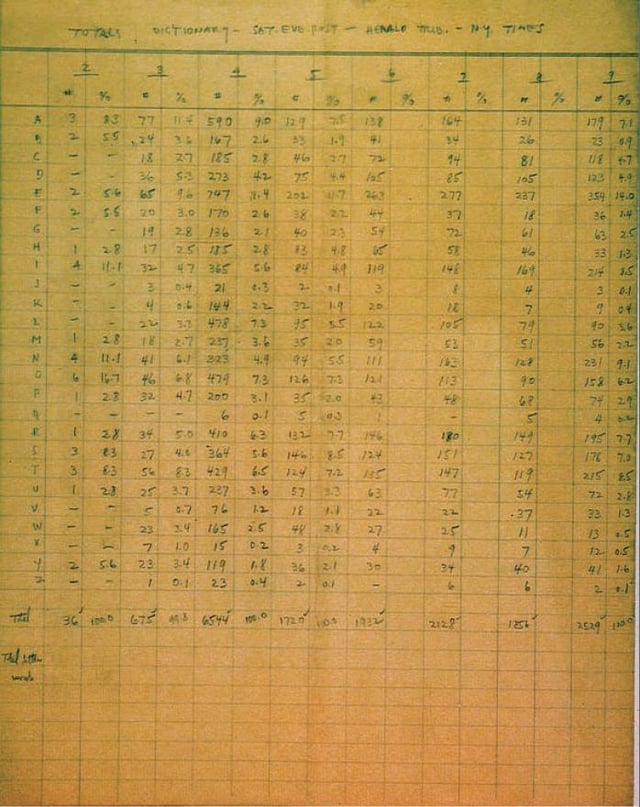
Alfred Butts manually tabulated the frequency of letters in words of various length, using examples in a dictionary, the Saturday Evening Post , the New York Herald Tribune , and The New York Times
Before the game, a resource, either a word list or a dictionary, is selected for the purpose of adjudicating any challenges during the game.
The letter tiles are either put in an opaque bag or placed face down on a flat surface.
Opaque cloth bags and customized tiles are staples of clubs and tournaments, where games are rarely played without both.
Next, players decide the order in which they play.
The normal approach is for players to each draw one tile: The player who picks the letter closest to the beginning of the alphabet goes first, with blank tiles taking precedence over the letter 'A'.
In most North American tournaments, the rules of the US-based North American Scrabble Players Association (NASPA) stipulate instead that players who have gone first in the fewest number of previous games in the tournament go first, and when that rule yields a tie, those who have gone second the most go first. If there is still a tie, tiles are drawn as in the standard rules.
At the beginning of the game, each player draws seven tiles from the bag and places them on his or her rack, concealed from the other player(s).
Making a Play
The first played word must be at least two letters long, and cover H8 (the center square).
Thereafter, any move is made by using one or more tiles to place a word on the board.
This word may or may not use one or more tiles already on the board, but must join with the cluster of tiles already on the board.
On each turn, the player has three options:
Pass, forfeiting the turn and scoring nothing
Exchange one or more tiles for an equal number from the bag, scoring nothing, an option available only if at least seven tiles remain in the bag
Play at least one tile on the board, adding the value of all words formed to the player's cumulative score
A proper play uses one or more of the player's tiles to form a continuous string of letters that make a word (the play's "main word") on the board, reading either left-to-right or top-to-bottom.
The main word must either use the letters of one or more previously played words or else have at least one of its tiles horizontally or vertically adjacent to an already played word.
If any words other than the main word are formed by the play, they are scored as well, and are subject to the same criteria of acceptability.
See Scoring for more details.
A blank tile may represent any letter, and scores zero points, regardless of its placement or what letter it represents.
Its placement on a double-word or triple-word square causes the corresponding premium to be applied to the word(s) in which it is used.
Once a blank tile is placed, it remains that particular letter for the remainder of the game.
After making a play, the player announces the score for that play, then if the game is being played with a clock, starts his or her opponent's clock.
The player can change his play anytime his or her clock is running, but commits to the play when he or she starts the opponent's clock.
The player then draws tiles from the bag to replenish his or her rack to seven tiles.
If there are not enough tiles in the bag to do so, the player takes all the remaining tiles.
If a player has made a play and has not yet drawn a tile, the opponent may choose to challenge any or all words formed by the play. The player challenged must then look up the words in question using a specified word source (such as OTCWL, the Official Scrabble Players Dictionary , or CSW) and if any one of them is found to be unacceptable, the play is removed from the board, the player returns the newly played tiles to his or her rack and the turn is forfeited. In tournament play, a challenge may be to the entire play or any one or more words, and judges (human or computer) are used, so players are not entitled to know which word(s) are invalid. Penalties for unsuccessfully challenging an acceptable play vary in club and tournament play, and are described in greater detail below.
End of Game
Under North American tournament rules, the game ends when either
one player plays every tile on his or her rack, and there are no tiles remaining in the bag (regardless of the tiles on his or her opponent's rack)
at least six successive scoreless turns have occurred and either player decides to end the game
either player uses more than 10 minutes of overtime.
(For several years, a game could not end with a cumulative score of 0-0, but that is no longer the case, and such games have since occurred a number of times in tournament play, the winner being the player with the lower total point value on his or her rack.
)
When the game ends, each player's score is reduced by the sum of his or her unplayed letters.
In addition, if a player has used all of his or her letters (known as "going out" or "playing out"), the sum of the other player's unplayed letters is added to that player's score; in tournament play, a player who goes out adds twice that sum, and his or her opponent is not penalized.
Examples
Plays can be made in a number of ways (in what follows, it is assumed that the word JACK has been played on a previous turn; letters in parentheses represent tiles already on the board):
Adding one or more letters to an existing word, e.g. (JACK)S, HI(JACK), HI(JACK)ING.
"Hooking" a word and playing perpendicular to that word, e.g. playing IONIZES with the S hooked on (JACK) to make (JACK)S.
Playing perpendicular to a word, e.g. YEU(K)Y through the K in JACK.
Playing parallel to a word(s) forming several short words, e.g. CON played under (JACK) simultaneously forming (J)O and (A)N.
Any combination of these is allowed in a play, as long as all the letters placed on the board in one play lie in one row or column and are connected by a main word, and any run of tiles on two or more consecutive squares along a row or column constitutes a valid word.
Either on the first turn or on subsequent turns, words may read either left-to-right or top-to-bottom.
Diagonal plays are not allowed.
Scoring
The score for any play is determined this way:
Each new word formed in a play is scored separately, and then those scores are added up.
The value of each tile is indicated on the tile, and blank tiles are worth zero points.
The main word (defined as the word containing every played letter) is scored.
The letter values of the tiles are added up, and tiles placed on DLS and TLS are doubled and tripled in value, respectively.
Tiles placed on DWS or TWS squares double or triple the value of the word(s) that include those tiles.
In particular, the center square (H8) is considered a DWS, and the first play is doubled in value.
If any "hook" words are played (e.g. playing ANEROID while "hooking" the A to BETTING to make ABETTING), the scores for each word are added separately.
This is common for "parallel" plays that make up to eight words in one turn.
Premium squares apply only when newly placed tiles cover them.
Any subsequent plays do not count those premium squares.
If a player makes a play where the main word covers two DWS squares, the value of that word is doubled, then redoubled (i.e. 4× the word value).
Similarly, if the main word covers two TWS squares, the value of that word is tripled, then retripled (9× the word value).
Such plays are often referred to as "double-doubles" and "triple-triples" respectively.
It is theoretically possible to achieve a play covering three TWS squares (a 27× word score), although this is extremely improbable without constructive setup and collaboration.
Plays covering a DWS and a TWS simultaneously (6× the word value, or 18× if a DWS and two TWS squares are covered) are only possible if a player misses the center star on the first turn, and the play goes unchallenged (this is valid under North American tournament rules).
Finally, if seven tiles have been laid on the board in one turn, known as a "bingo", after all of the words formed have been scored, 50 bonus points are added.
When the letters to be drawn have run out, the final play can often determine the winner.
This is particularly the case in close games with more than two players.
Scoreless turns can occur when a player passes, exchanges tiles, or loses a challenge.
The latter rule varies slightly in international tournaments.
A scoreless turn can also theoretically occur if a play consists of only blank tiles, but this is extremely unlikely in actual play.
Example
Suppose Player 1 plays QUANT 8D, with the Q on a DLS and T on the center star.
The score for this play would be (2 × 10 + 1 + 1 + 1 + 1) × 2 = 48 (following the order of operations).
Player 2 extends the play to ALI(QUANT) 8A with the A on the TWS at 8A.
The score for this play would be (1 + 1 + 1 + 10 + 1 + 1 + 1 + 1) × 3 = 51.
Note that the Q is not doubled for this play.
Player 1 has DDIIIOO and plays OIDIOID 9G.
The score for the word OIDIOID would be (2 × 1 + 1 + 2 × 2 + 1 + 1 + 1 + 2 × 2) = 14.
Additionally, Player 1 formed NO and TI, which score 1 + 2 × 1 = 3 and 1 + 1 = 2 points respectively.
Therefore, the sum of all the values of the words formed is 14+3+2 = 19.
However, this is a seven-letter play, so 50 points are added, resulting in a total score of 69.
Player 1 now has a 117-51 lead.
The player with the highest final score wins the game.
In case of a tie, the player with the highest score before adjusting for unplayed tiles wins the game.
In tournament play, a tie counts as 1/2 a win for both players.
Acceptable words
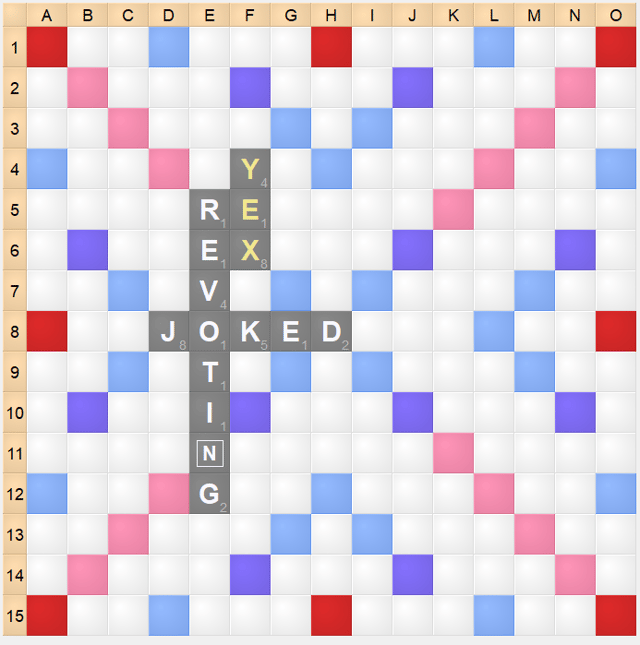
An example of a Scrabble game in progress using Quackle, an open-source program.
Acceptable words are the primary entries in some chosen dictionary, and all of their inflected forms. Words that are hyphenated, capitalized (such as proper nouns), or apostrophized are not allowed, unless they also appear as acceptable entries; JACK is a proper noun, but the word JACK is acceptable because it has other usages as a common noun (automotive, vexillological, etc.) and verb that are acceptable. Acronyms or abbreviations, other than those that have acceptable entries (such as AWOL , RADAR , LASER , and SCUBA ) are not allowed. Variant spellings, slang or offensive terms, archaic or obsolete terms, and specialized jargon words are allowed if they meet all other criteria for acceptability; though archaic spellings (e.g. NEEDE for NEED) are generally not allowed. Foreign words are not allowed in the English language Scrabble unless they have been incorporated into the English language – for example, the words PATISSERIE, KILIM, and QI. Vulgar and offensive words are generally excluded from the OSPD4, but are allowed in club and tournament play.
Proper nouns and other exceptions to the usual rules are allowed in some limited contexts in the spin-off game Scrabble Trickster. Names of recognized computer programs are permitted as an acceptable proper noun (For example, WinZIP).
There are two popular competition word lists used in various parts of the world: TWL and SOWPODS (also referred to as "Collins" or "CSW"). The memorization of two-letter words is considered an essential skill in this game.
OWL2 and OSPD5
The North American 2006 Official Tournament and Club Word List, Second Edition (OWL2) went into official use in American, Canadian, Israeli and Thai club and tournament play on March 1, 2006 (or, for school use, the bowdlerized Official Scrabble Players Dictionary, Fifth Edition (OSPD5)). North American competitions use the Long Words List for longer words.
The OWL2 and the OSPD5 are compiled using four (originally five) major college-level dictionaries, including Merriam-Webster (10th and 11th editions, respectively).
If a word appears, at least historically, in any one of the dictionaries, it will be included in the OWL2 and the OSPD5.
If the word has only an offensive meaning, it is only included in the OWL2.
The key difference between the OSPD5 and the OWL2 is that the OSPD5 is marketed for "home and school" use, with expurgated words which their source dictionaries judged offensive, rendering the Official Scrabble Players Dictionary less fit for official Scrabble play. The OSPD5, released in 2014, is available in bookstores, whereas the OWL2 is only available through NASPA).
Collins Scrabble Words
In all other English-speaking countries, the competition word list is Collins Scrabble Words 2015 edition, known as CSW15. Versions of this lexicon prior to 2007 were known as SOWPODS. The lexicon includes all allowed words of length 2 to 15 letters. This list contains all OWL2 words plus words sourced from Chambers and Collins English dictionaries. This book is used to adjudicate at the World Scrabble Championship and all other major international competitions outside of North America.
Tournaments are also occasionally played to CSW in North America, particularly since 2010.
NASPA officially rates CSW tournaments alongside OWL tournaments, using a separate rating system.
Challenges
The penalty for a successfully challenged play is nearly universal: the offending player removes the tiles played and forfeits his or her turn.
(However, in some online games, an option known as "void" may be used, wherein unacceptable words are automatically rejected by the program.
The player is then required to make another play, with no penalty applied.)
The penalty for an unsuccessful challenge (where all words formed by the play are deemed valid) varies considerably, including:
"Double Challenge", in which an unsuccessfully challenging player must forfeit the next turn.
This penalty governs North American (NASPA-sanctioned) OWL tournament play, and is the standard for North American, Israeli, and Thai clubs.
Because loss of a turn generally constitutes the greatest risk for an unsuccessful challenge, it provides the greatest incentive for a player to "bluff", or play a "phony" – a plausible word that they know or suspect to be unacceptable, hoping his or her opponent will not call him on it.
Or a player can put down a legal word that appears to be a phony hoping the other player will incorrectly challenge it and lose their turn.
"Single Challenge"/"Free Challenge", in which no penalty whatsoever is applied to a player who unsuccessfully challenges.
This is the default rule in Ireland and the United Kingdom, as well as for many tournaments in Australia, although these countries do sanction occasional tournaments using other challenge rules.
Modified "Single Challenge", in which an unsuccessful challenge does not result in the loss of the challenging player's turn, but is penalized by the loss of a specified number of points.
The most common penalty is five points.
The rule has been adopted in Singapore (since 2000), Malaysia (since 2002), South Africa (since 2003), New Zealand (since 2004), and Kenya, as well as in contemporary World Scrabble Championships (since 2001) and North American (NASPA-sanctioned) Collins tournaments. Some countries and tournaments (including Sweden) use a 10-point penalty instead. In most game situations, this penalty is much lower than that of the "double challenge" rule. Consequently, such tournaments encourage a greater willingness to challenge and a lower willingness to play dubious words.
Under NASPA tournament rules, a player may request to "hold" the opponent's play in order to consider whether to challenge it, provided that the opponent has not yet drawn replacement tiles.
If player A holds, player A's clock still runs, and player B may not draw provisional replacement tiles until 15 seconds after the hold was announced (which tiles must then be kept separate).
There is no time limit on how long player A may hold the play.
If player A successfully challenges after player B drew provisional replacement tiles, player B must show the drawn tiles before returning them to the bag.
Club and tournament play
Tens of thousands play club and tournament Scrabble worldwide. All tournament (and most club) games are played with a game clock and a set time control. Although casual games are often played with unlimited time, this is problematic in competitive play among players for whom the number of evident legal plays is immense. Almost all tournament games involve only two players; typically, each has 25 minutes in which to make all of his or her plays. For each minute by which a player oversteps the time control, a penalty of 10 points is assessed. The number of minutes is rounded up, so, for example, if a player oversteps time control by two minutes and five seconds, the penalty is 30 points. Also, most players use molded plastic tiles, not engraved like the original wooden tiles, eliminating the potential for a cheating player to "braille" (feel for particular tiles, especially blanks, in the bag).
Players are allowed "tracking sheets", pre-printed with the letters in the initial pool, from which tiles can be crossed off as they are played.
Tracking tiles is an important aid to strategy, especially during the endgame, when no tiles remain to be drawn and each player can determine exactly what is on the opponent's rack.
Notable and regularly held tournaments include:
World Scrabble Championship : held in odd years up until 2013, when it was announced by Mattel that it would be called the Scrabble Champions Tournament and be held annually in subsequent years.
The WESPA Championship: held in odd years beginning from 2015 and is organised by WESPA, the World English-language Scrabble Players' Association
North American Scrabble Championship
National Scrabble Championship
Brand's Crossword Game King's Cup
UK Open : the largest Scrabble tournament in Europe, held annually in Coventry, United Kingdom since 2008.
Other important tournaments include:
World Youth Scrabble Championships
National School Scrabble Championship
Canadian Scrabble Championship
Singapore Open Scrabble Championship
Clubs in North America typically meet one day a week for three or four hours and some charge a small admission fee to cover their expenses and prizes.
Clubs also typically hold at least one open tournament per year.
Tournaments are usually held on weekends, and between six and nine games are played each day.
There are also clubs in the UK and many other countries.
There are a number of internationally rated SOWPODS-tournaments.
During off hours at tournaments, many players socialize by playing consultation (team) Scrabble, Clabbers, Anagrams, Boggle, Words with Friends, Scramble with Friends and other games.
Computer players
Maven is a computer opponent for the game, created by Brian Sheppard. The official Scrabble computer game in North America uses a version of Maven as its artificial intelligence and is published by Atari. Outside of North America, the official Scrabble computer game is published by Ubisoft. Quackle is an open-source alternative to Maven of comparable strength, created by a five-person team led by Jason Katz-Brown.
Console and computer video game versions
Several computer and video game versions of Scrabble have been released for various platforms, including PC, Mac, Amiga, Commodore 64, Sinclair ZX Spectrum, Game Boy, Game Boy Color, Game Boy Advance, Nintendo DS, PlayStation, PlayStation 2, PlayStation Portable, iPod, iPad, Game.com, Palm OS, Amstrad CPC, Xbox 360, Kindle, and mobile phones.
The Nintendo DS version of Scrabble 2007 Edition made news when parents became angry over the game's AI using potentially offensive language during gameplay.
Web versions
A number of web sites offer the possibility to play Scrabble online against other users, such as the Internet Scrabble Club and www.pogo.com from Electronic Arts.
Facebook initially offered a variation of Scrabble called Scrabulous as a third-party application add-on. On July 24, 2008, Hasbro filed a copyright infringement lawsuit against the creators of Scrabulous. Four days later, Scrabulous was disabled for users in North America, eventually re-appearing as "Lexulous" in September 2008, with changes made to distinguish it from Scrabble. By December 20, Hasbro had withdrawn its lawsuit.
Mattel launched its official version of online Scrabble, Scrabble by Mattel, on Facebook in late March 2008. The application was developed by Gamehouse, a division of RealNetworks who had been licensed by Mattel. However, since Hasbro controls the copyright for North America with the copyright for the rest of the world belonging Mattel, the Gamehouse Facebook application was available only to players outside the United States and Canada. Meanwhile, the version developed by developed by Electronic Arts for Hasbro was available throughout the world.
When Gamehouse ceased support for their application, Mattel replaced it with the Electronic Arts version in May 2013.
This decision was met with criticism from its user base.
The Hasbro version continues to be available worldwide but now uses IP lookup to display Hasbro branding to North American players and Mattel branding to the rest of the world.
Electronic Arts has also released mobile apps for Android and iOS, allowing players to continue the same game on more than one platform.
As well as facilities to play occasional games online, there are many options to play in leagues.
The biggest of these is the Facebook Scrabble League.
Television game show versions
In 1987, a board game was released by Selchow & Righter, based on the game show hosted by Chuck Woolery, which aired on NBC from 1984 to 1990 (and for five months in 1993). Billed as the "Official Home Version" of the game show (or officially as the "TV Scrabble Home Game"), game play bears more resemblance to the game show than it does to a traditional Scrabble game, although it does utilize a traditional Scrabble gameboard in play.
On September 17, 2011, a new game show based on Scrabble, called Scrabble Showdown , debuted on The Hub with Justin "Kredible" Willman as the host of the program. Each week, teams play various activities based on the board game in order to win big prizes including a trip to anywhere from around the world.
Super Scrabble
A new licensed product, Super Scrabble
Records
The following records were achieved during competitive club or tournament play, according to authoritative sources, including the book Everything Scrabble by Joe Edley and John D. Williams, Jr. (revised edition, Pocket Books, 2001) and the Scrabble FAQ. When available, separate records are listed based upon different official word lists:
OSPD or OTCWL, the North American list also used in Thailand and Israel;
OSW, formerly the official list in the UK;
SOWPODS, the combined OSPD+OSW now used in much of the world, known today as Collins Scrabble Words
High game (OSPD) – 830 by Michael Cresta (Mass.), at the Lexington (Mass.) club, October 12, 2006. Cresta defeated Wayne Yorra 830-490.
High game (OSPD) in a tournament game- 803 by Joel Sherman (N.Y.), at a tournament in Stamford, Conn., December 9, 2011. Sherman defeated Bradley Robbins 803-285. Sherman played a record-tying seven bingoes in that game and stuck Robbins with the Q.
High game (OSW) – 793 by Peter Preston (UK), 1999.
High game (SOWPODS) – Toh Weibin set a record score of 850 at the Northern Ireland Championships on 21 January 2012. The winning margin of 591 points is also believed to be a record.
High combined score (OSPD) – 1320 (830-490) by Michael Cresta and Wayne Yorra, in a Lexington, Mass., club, 2006.
High combined score (OSPD) in a tournament game – 1134 (582-552) by Keith Smith (Tex.) and Stefan Rau (Conn.), Round 12 of the 2008 Dallas Open. (Rau's losing score of 552 included three phony words which were not challenged.)
High combined score (OSPD) in a tournament game with no phony words played – 1127 (725-402) by Laurie Cohen (Ariz.) and Nigel Peltier (Wash.), in a tournament in Ahwatukee, Arizona, February 16, 2009.
High combined score (SOWPODS) – 1210 (721-489) by Edward Okulicz (Australia and Michael McKenna (Australia), at the 2013 Janboree in NSW.
Highest losing score (OSPD) – 552 by Stefan Rau (Conn.) to Keith Smith's (Tex.) 582, Round 12 of the 2008 Dallas Open.
Highest tie game (OSPD) – 502-502 by John Chew and Zev Kaufman, at a 1997 Toronto Club tournament.
Highest tie game (SOWPODS) – 532-532 by Sinatarn Pattanasuwanna (Thailand) and Tawan Paepolsiri (Thailand) at the 2012 World Youth Scrabble Championship.
Highest opening move score (OSPD) – MuZJIKS (with a blank for the U) 126 by Jesse Inman (S.C.) at the National Scrabble Championship, 2008. The highest possible legal score on a first turn is MUZJIKS 128, using an actual U rather than a blank. (Note: The odds of potentially opening with MUZJIKS without blanks is about 1 in 55,581,808)
Highest opening move score (SOWPODS) – BEZIQUE 124 by Sam Kantimathi (1993), Joan Rosenthal and Sally Martin.
Highest single play (OSPD) – QUIXOTRY 365 by Michael Cresta (Mass.), 2006.
Highest single play (SOWPODS) – CAZIQUES 392 by Karl Khoshnaw.
Highest average score, multi-day tournament (OSPD) – 503 by James Leong (Sask.) over 12 rounds at Brandon, Man., 2015. 484 by Doug Brockmeier (Calif.) over 12 rounds at Elmhurst, Ill., 2011. 471 by Chris Cree (Tex.) over 18 rounds at the Bayou Bash in Houston, Tex., 2007.
Highest average score, multi-day tournament (SOWPODS) – 521 by Ganesh Asirvatham (MY) over 20 rounds at the Causeway Singapore vs Malaysia held in Malaysia in 2017.
Two other records are believed to have been achieved under a British format known as the "high score rule", in which a player's tournament result is determined only by the player's own scores, and not by the differentials between that player's scores and the opponents'.
Play in this system "encourages elaborate setups often independently mined by the two players", and is significantly different from the standard game in which defensive considerations play a major role.
While the "high score" rule has led to impressively high records, it is currently out of favor.
High game score of 1,049 by Phil Appleby of Lymington, Hampshire, UK, on June 25, 1989 in Wormley, Hertfordshire, UK. his opponent scored just 253 points, giving Appleby a record victory margin of 796 points.
High single-turn score of 392, by Dr. Saladin Karl Khoshnaw in Manchester, UK, in April 1982. The word he used was CAZIQUES
Hypothetical scores in possible and legal but highly unlikely plays and games are far higher, primarily through the use of words that cover three triple-word-score squares.
The highest reported score for a single play is 1780 (OSPD) and 1785 (SOWPODS) using oxyphenbutazone. When only adding the word sesquioxidizing to these official lists, one could theoretically score 2015 (OSPD) and 2044 (SOWPODS) points in a single move. The highest reported combined score for a theoretical game based on SOWPODS is 4046 points. Other records are available for viewing at (PDF)., an unofficial record book which includes the above as sources and expands on other topics.
In August 1984, Peter Finan and Neil Smith played Scrabble for 153 hours at St. Anselm's College, Birkenhead, Merseyside, setting a new duration record. A longer record was never recorded by Guinness Book of Records, as the publishers decided that duration records of this nature were becoming too dangerous, and stopped accepting them.
National versions
Versions of the game have been released in several other languages.
The game was called Alfapet when it was introduced in Sweden in 1954. However, since the mid-1990s, the game has also been known as Scrabble in Sweden. Alfapet is now another crossword game, created by the owners of the name Alfapet. A Russian version is called Erudit. Versions have been prepared for Dakotah, Haitian Creole, Dakelh (Carrier language), and Tuvan.
An Irish language version of Scrabble was published by Glór na nGael in 2010.
The previous year the same organisation had published the Junior version of the game and two years later republished Junior Scrabble using a two sided (and two skill level) board.
Variations
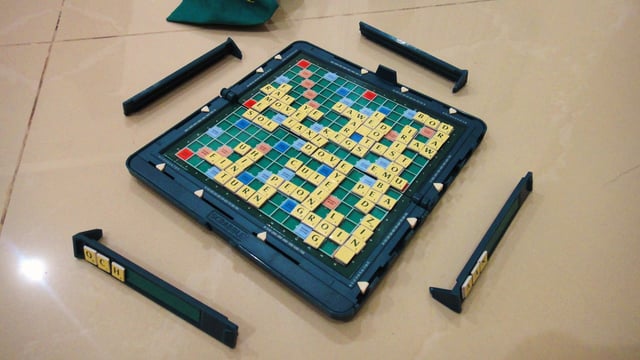
A near-ending game board, tiles and racks of the magnetic Pocket Scrabble (International, Mattel, Inc.)
There are numerous variations of the game.
While these games are similar to the original Scrabble game, they include minor variations. For example, Literati draws random tiles instead of providing a finite number of tiles for the game, assigns different point levels to each letter and has a slightly different board layout whereas Lexulous assigns eight letters to each player instead of the customary seven. Words with Friends uses a different board layout and different letter values and so do Words of Gold.
Duplicate Scrabble is a popular variant in French speaking countries. Every player has the same letters on the same board and the players must submit a paper slip at the end of the allotted time (usually 3 minutes) with the highest scoring word they have found. This is the format used for the French World Scrabble Championships but it is also used in Romanian and Dutch. There is no limit to the number of players that can be involved in one game, and at Vichy in 1998 there were 1485 players, a record for French Scrabble tournaments.
Scarabeo is a variant that is much more popular in Italy than the original game. It features a 17×17 grid of cells and peculiar rules.
In one variation of Scrabble, blanks actually do score points corresponding to the letter which the blank is used to represent. For example, if one played blank to represent a "Z", it would get ten; a blank to represent a V or an H would get four; a blank to represent a D would get 2 and blank to represent a T, N, L, S or R or any of the vowels would get one.
A junior version, called Junior Scrabble, has been marketed. This has slightly different distributions of frequencies of letter tiles to the standard Scrabble game.
Word games similar to or influenced by Scrabble include Bananagrams, Boggle, Dabble, Nab-It!, Perquackey, Puzzlage, Quiddler, Scribbage, Tapple, Upwords, and WordSpot and also Words of Gold.
There are also number based variations, such as Equate (game), GoSum, Mathable, Numble, Numbler, Triolet, Yushino and Numenko.
Gameboard formats
The game has been released in numerous gameboard formats appealing to various user groups.
The original boards included wood tiles and many "deluxe" sets still do.
Tile Lock Scrabble and Tile Lock Super Scrabble Editions
Both games are made by Winning Moves and feature smaller, plastic tiles that are held in place on the board with little plastic posts. The standard version features exactly the same 100 tiles as regular Scrabble. The Tile Lock Super Scrabble features the same 200 tiles that are in Super Scrabble.
Travel editions
Editions are available for travelers who may wish to play in a conveyance such as a train or plane, or who may wish to pause a game in progress and resume later.
Many versions thus include methods to keep letters from moving, such as pegboards, recessed tile holders and magnetic tiles.
Players' trays are also designed with stay-fast holders.
Such boards are also typically designed to be re-oriented by each player to put the board upright during the game, as well as folded and stowed with the game in progress.
Production and Marketing Company, 1954 – metal hinged box, Bakelite tiles inlaid with round magnets, chrome tile racks, silver colored plastic bag and cardboard box covered with decorative paper.
The box, when opened flat, measures 8½″ × 7¾″ (21.6 × 19.7 cm) and the tiles measure ½″ × ½″ (12.7 × 12.7 mm) each.
Spear's Games, 1980s – boxed edition with pegboard, plastic tiles with small feet to fit snugly in the pegboard.
Racks are clear plastic, allowing some sorting while holding tiles fairly snugly.
Set comes with a drawstring plastic bag to draw tiles and a cardboard box.
It is possible to save a game in progress by returning the board to the box.
There is risk of players' trays being mixed and upset, and the box lid, held on by friction, is subject to upset.
Selchow & Righter, 1980s – pocket edition with plastic "magnetic" board and tiles.
Tile racks are also plastic with asymmetrical shape to provide handhold.
All elements fit in a plastic envelope for travel and to permit a pause in the game.
Plastic letters are very small and tend to lose their grip if not placed with slight lateral movement and if they are not perfectly clean.
Game format is extremely small, allowing Scrabble games for backpackers and others concerned about weight and size.
Hasbro Games, 2001 – hinged plastic board with clear tile-shaped depressions to hold tiles in play.
Board is in a black, zippered folio such that board and tiles may be folded for travel, even with game in play.
Reverse side of board contains numbered mounts for racks, holding tiles face down, allowing secure and confidential storage of tiles while game is paused.
Some versions have tile racks with individual tile slots, thus not permitting easy sorting of tiles in rack.
The board, when opened up, measures 24.5 × 21.0 cm, and the tiles are 12.3 × 12.3 × 6.7 mm in size.
Deluxe editions
At the opposite end, some "deluxe" editions offer superior materials and features.
These include editions on a rotating turntable so players can always face the board with the letters upright and a raised grid that holds the tiles in place.
More serious players often favor custom Scrabble boards, often made of acrylic glass or hardwood, that have superior rotating mechanisms and personalized graphics.
Large print edition
An edition has been released (in association with the RNIB) with larger board and letters for players with impaired vision. The colours on the board are more contrasting and the font size is increased from 16 to 24 point. The tiles are in bold 48 point.
Works detailing tournamentScrabble
An introduction to tournament Scrabble and its players can be found in the book Word Freak by Stefan Fatsis. In the process of writing, Fatsis himself progressed into a high-rated tournament player.
The Scrabble Player's Handbook, edited by Stewart Holden and written by an international group of tournament players, gives the information a serious player needs to advance to successful tournament play.
There have been numerous documentaries made about the game, including:
Word Wars (2004) by Eric Chaikin and Julian Petrillo, about the "tiles and tribulations on the Scrabble game circuit".
Scrabylon (2003), by Scott Petersen, which "gives an up-close look at why people get so obsessed with that seemingly benign game". WorldCat ID.
Word Slingers by Eric Siblin and Stefan Vanderland (produced for CBC, 2002), which follows four expert Canadian players at the 2001 World Championship in Las Vegas.
In popular culture
In the Honeymooners episode "Boys & Girls Together," Ed Norton (played by Art Carney) talks about playing Scrabble with the professors at NYU.
Scrabble is featured in several episodes of Two and a Half Men , including "Dead from the Waist Down" and "Phase One, Complete."
The game is featured in Foul Play
The game is featured in The Simpsons episode "Bart the Genius" where Bart plays the made-up word "Kwyjibo " during a match with the family. When confronted by Homer, Bart provides the definition as "a big, [silly], balding North American ape with no chin".
In the novel and subsequent film and TV show The Handmaid's Tale
See also
Anamonic
Blanagram
RSVP (board game)
Upwords
Wordscraper
Words with Friends
Scrabble in Hong Kong
Countdown (game show)
